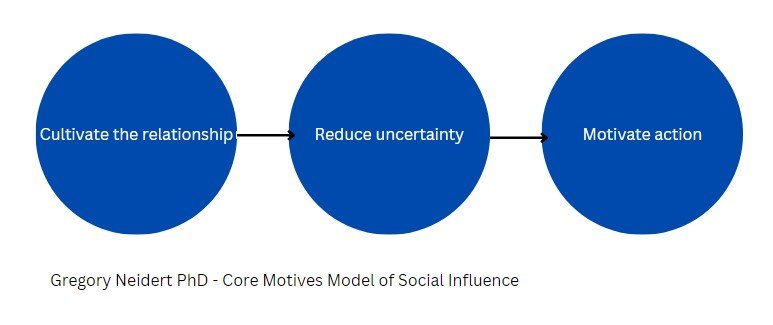I want to help as many people as possible to get others to say “yes” to them more often, by growing their understanding of ethical influence practices.
This is valid in all aspects of business and life.
From Dr Robert Cialdini’s book, Influence, many of you will already know the 7 principles of influence.
The challenge is knowing which principle to use and when to use it, for maximum effectiveness and efficiency.
For example, if you’ve not yet built a relationship with the other person, starting by using the principle of scarcity (“You’d better buy this now, this special deal is for today only”) is going to come across as pushy at best, and might get your counterpart to run to the hills!
Fortunately, Dr Gregory Neidert created the Core Motives Model of Social Influence. His model categorises the 3 stages of the influence process and identifies the specific Cialdini influence principle to apply for maximum impact.

Let’s suppose you’re at the start of your influence journey. Your focus at this stage should be on cultivating a relationship with the person you’d like to influence, be they a potential customer, a business stakeholder, a supplier or anyone.
You’re going to want to connect with them on a personal level, building rapport, trust and goodwill.
The relevant principles to apply here are:
1. Liking – you simply HAVE to be liked by the other person (and preferably, you must find something to like about them, too) if you’re to have any chance of being able to influence them. Can you remember a time when you willingly bought something from someone you didn’t like? No? Exactly.
2. Reciprocity – this is hugely powerful. If someone grants us a favour or provides us with a gift or something we find valuable (it doesn’t have to have any monetary value, either) we feel compelled to repay them.
3. Unity – finding something that binds you and the other party, some common ground (maybe you grew up in the same town, support the same sports team or in the extreme, have a deep love for Czech ceramics) creates a shared bond.
Of course, there’s lots more to this, plus there are techniques that activate and amplify the principles with astounding effects.
Look out for my follow-up blog where I’ll cover the influence principles to apply at stage 2 of the core motives model.
⭐
PS. If only I’d known about Neidert’s core motives model when I was trying to influence an internal Marketing stakeholder years ago.
He never returned my calls, and when I finally got him to agree to speak to me at an agreed time, I could hear him having a wee in the background! That’s how little he thought of me!!